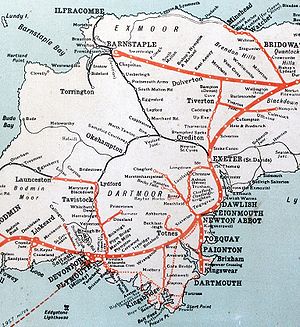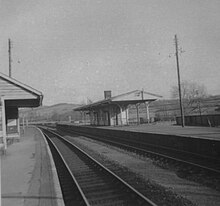Tarka Line
| Tarka Line | |||||||||||||||||||||||||||||||||||||||||||||||||||||||||||||||||||||||||||||||||||||||||||||||||||||||||||||||||||||||||||||||||||||||||||||||||||||||||
|---|---|---|---|---|---|---|---|---|---|---|---|---|---|---|---|---|---|---|---|---|---|---|---|---|---|---|---|---|---|---|---|---|---|---|---|---|---|---|---|---|---|---|---|---|---|---|---|---|---|---|---|---|---|---|---|---|---|---|---|---|---|---|---|---|---|---|---|---|---|---|---|---|---|---|---|---|---|---|---|---|---|---|---|---|---|---|---|---|---|---|---|---|---|---|---|---|---|---|---|---|---|---|---|---|---|---|---|---|---|---|---|---|---|---|---|---|---|---|---|---|---|---|---|---|---|---|---|---|---|---|---|---|---|---|---|---|---|---|---|---|---|---|---|---|---|---|---|---|---|---|---|---|---|
|
Start of the Tarka Line (left branch) at Cowley Bridge Junction
| |||||||||||||||||||||||||||||||||||||||||||||||||||||||||||||||||||||||||||||||||||||||||||||||||||||||||||||||||||||||||||||||||||||||||||||||||||||||||
|
Map section 1930s: black route in the middle of the map
| |||||||||||||||||||||||||||||||||||||||||||||||||||||||||||||||||||||||||||||||||||||||||||||||||||||||||||||||||||||||||||||||||||||||||||||||||||||||||
| Gauge : | 1435 mm ( standard gauge ) | ||||||||||||||||||||||||||||||||||||||||||||||||||||||||||||||||||||||||||||||||||||||||||||||||||||||||||||||||||||||||||||||||||||||||||||||||||||||||
|
|||||||||||||||||||||||||||||||||||||||||||||||||||||||||||||||||||||||||||||||||||||||||||||||||||||||||||||||||||||||||||||||||||||||||||||||||||||||||
The Tarka Line is a single track railway line in the county of Devon in South West England . It connects the two cities of Exeter and Barnstaple and is 62.8 kilometers long. In the village of Yeoford , a 25-kilometer branch line branches off to Okehampton ( Dartmoor Railway ), which has been in operation again since 1997 in the summer months.
Beyond Barnstaple Junction, the line used to continue to Ilfracombe ( North Devon Railway ).
Since 1991 the route has been operated by the Devon and Cornwall Rail Partnership , the UK's largest service provider for municipal passenger transport. The identification animal of the route, which also characterizes the route logo, is the sea otter. It was borrowed from Henry Williamson's 1927 novella Tarka the Otter (Tarka the Otter).
13 pairs of trains run between 7 a.m. and 10 p.m. on weekdays, half as many on Sundays.
history
The line was originally built by the North Devon Railway (NDR), opened in 1851 and later operated by the London and South Western Railway (L & SWR) after its takeover . Together with the opening of Barnstaple Junction station in 1854, the line was extended to the north.
A little later, the line was in direct competition with the Devon and Sommerset Railway (D&SR), which was operated in broad gauge, ran from Taunton to Barnstaple and was completed in 1871. Due to its own rail profile, the D&SR had its own station - Barnstaple Victoria Street - which was right on the then development line of the city, while Barnstaple Junction was on the opposite side of the River Taw . After switching to standard gauge in 1881, a connecting line was established between the two stations in 1887. At that time the L & SWR had already taken over the NDR.
The northern extension led to Ilfracombe from 1874 . It had another station in Barnstaple ( Barnstaple Town or Barnstaple Quay ), from 1898 with a connection to the narrow-gauge Lynton and Barnstaple Railway , which, however, ceased operations in 1935.
Another extension led from 1924 west to Taunton and Bideford, which was gradually shut down again in 1965/66. Today it is the core section of the 180-mile-long Tarka Trail , which can be used as a walking and cycling path.
The L & SWR had reached Exeter from London in 1860 and continued to build from Coleford Junction to Okehampton in 1871 and to Plymouth in 1876 .
In 1972 the branch via Okehampton, originally the more important of the two routes, was shut down as one of the last routes as part of the Beeching ax . Only the section to Okehampton was retained for freight traffic.
Operational management
The management has been in the hands of First Great Western since 1991 . Since then, the transport figures have changed positively, as can be seen in the table below. The passengers arriving and departing for the annual period April-March are given:
| 2002-03 | 2004-05 | 2005-06 | 2006-07 | 2007-08 | |
|---|---|---|---|---|---|
| Newton St Cyres | 1,147 | 702 | 780 | 889 | 1,662 |
| Crediton | 21,607 | 22,478 | 22,550 | 24,021 | 27,422 |
| Yeoford | 7,993 | 6,883 | 6,848 | 7,701 | 7,445 |
| Copplestone | 1,231 | 356 | 1,090 | 2,283 | 4,563 |
| Morchard Road | 4,676 | 3,442 | 2.712 | 2,341 | 2,904 |
| Lapford | 4,912 | 2,104 | 1,658 | 2,208 | 1,967 |
| Eggesford | 11,430 | 14,152 | 16.009 | 18,184 | 18,658 |
| Kings Nympton | 4.013 | 2,400 | 1,781 | 1.009 | 1,033 |
| Portsmouth Arms | 614 | 372 | 510 | 667 | 1.012 |
| Umberleigh | 7,951 | 8,301 | 10,408 | 12,564 | 13,811 |
| Chapelton | 734 | 472 | 161 | 120 | 208 |
| Barnstaple | 176,682 | 194.474 | 210,846 | 238.082 | 261.174 |
The route to Okehampton, which was reopened in 1997, carried almost 233,000 passengers in the first year after reopening, and 342,000 passengers in the fifth year of operation, an increase of 47 percent.
British Rail diesel multiple units in classes 142, 143, 150 and 153 are used on the route .
Web links
Individual evidence
- ↑ Archived copy ( memento of the original from June 21, 2011 in the Internet Archive ) Info: The archive link was inserted automatically and has not yet been checked. Please check the original and archive link according to the instructions and then remove this notice.
- ↑ Archived copy ( memento of the original from September 26, 2010 in the Internet Archive ) Info: The archive link was inserted automatically and has not yet been checked. Please check the original and archive link according to the instructions and then remove this notice.
- ↑ http://www.disused-stations.org.uk/b/barnstaple_town/index.shtml
- ↑ http://www.rail-reg.gov.uk/server/show/nav.1529


